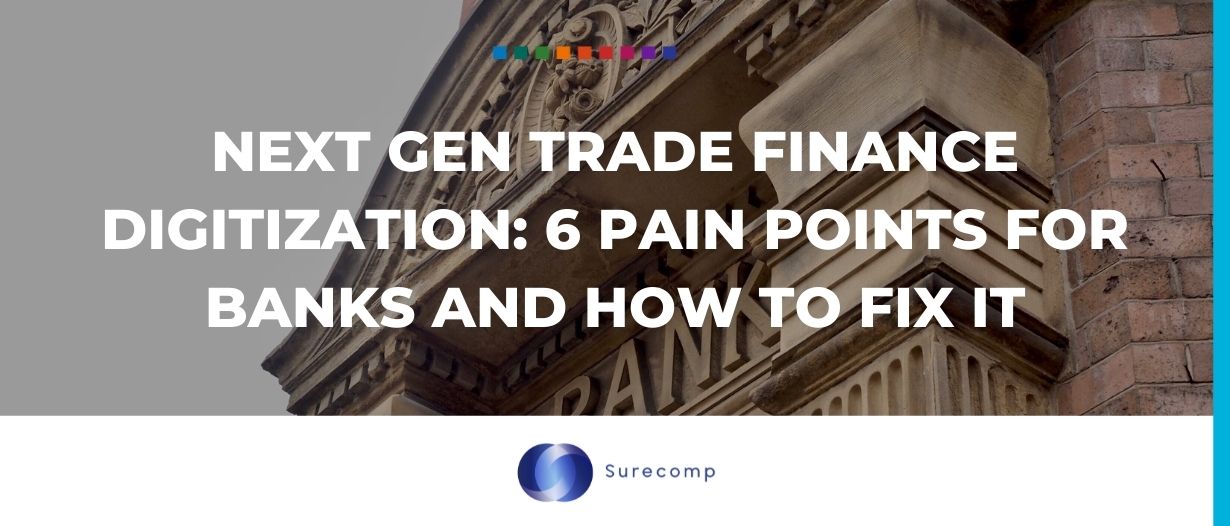The need for trade finance digitization has never been clearer. In today’s pandemic-ravaged landscape, banks face multiple challenges, including the legislative shift to digital trade documents and growing regulatory scrutiny, changing customer behaviour and increasing competition in the form of trade finance investment funds. In light of these challenges, it’s essential that banks embrace the opportunities brought by digitization – and that means embracing digital solutions that not only deliver cost savings and efficiencies, but also harness ecosystem interoperability brought by emerging technologies, and the opportunities for customer satisfaction, collaboration and growth.
Pain points for banks
Where trade finance is concerned, banks are focusing on a number of different pain points in today’s rapidly evolving market:
- Regulatory scrutiny from banks around the globe. In a survey conducted by the ICC last year, six out of ten bankers said they are extremely concerned about compliance, with specific concerns including Anti-Money Laundering (AML), Know Your Customer (KYC), Counter-Terrorist Financing (CTF) and sanctions. The challenge here is that regulators do not take a uniform approach, meaning that banks have to address disparate regulations across major markets like the US, UK, Hong Kong and Singapore, as well as in local markets in which they have headquarters, subsidiaries or affiliates.
- Rising cost of doing business. For banks engaged in trade finance, the economics are a considerable concern. For one thing, the cost of transactions is high, while fee income is low in an increasingly competitive marketplace. Compliance costs are rising due to the growing focus on KYC and AML – and while Basel IV is a regulatory consideration, it also has implications for the economics of trade finance, with the potential to increase the cost of doing business for banks by up to 50%.
- Shift to digital trade documents. The G7 digital and technology ministers recently committed to the digitization of international trade transactions, adding considerable impetus to the shift towards electronic transferable records in trade. With data issued last year showing that only 0.1% of bills of lading are issued electronically, it’s clear that there is much room for improvement. As this shift continues, it will be increasingly important for banks to have solutions in place that enable them to receive and process electronic records so that clients can make use of these instruments.
- Engaging with fintechs. While innovation is picking up speed, at this point of development it is also posing some additional challenges for banks. With fintechs developing myriad platforms to harness technologies like Distributed Ledger Technology (DLT), it’s essential for banks to be able to connect to the platforms used by their corporate customers. At this stage, however, there is no clarity about which of the systems currently being developed will eventually see widespread adoption.
- Changes to customer behaviour. The people who work for corporations are also consumers who use their mobile phones outside of the office – and their experiences are being shaped by the convenience offered by consumer technology. For example, if people are able to order goods for same day delivery in their personal lives, they are less willing to accept waiting five days to receive physical documents.
- New competition from investment firms. With interest rates remaining low in Europe and the US, and rising levels of liquidity in the market, trade finance is becoming an increasingly interesting asset class. As such, investment firms are increasingly looking to invest in trade finance assets – indeed, S&P estimates that there are as many as 20 specialist trade finance investment funds. While this brings competitive pressure for banks, at this stage few have devised a strategic plan about how best to handle this competition.

Addressing the challenges
Fortunately, there is much that banks can do to navigate these issues successfully. In particular, technology has an important role to play in helping banks adapt – not least because a strong back-office solution is the foundation of any digitization strategy.
In many cases, banks’ IT infrastructures have evolved over a number of years, with different systems and technology platforms in place to cover different countries of operation. These systems will each have their own licensing and support agreements – and as a result, the cost of maintaining the existing architecture can erode the profitability of the business.
Leveraging a comprehensive solution that covers the full remit of trade finance instruments, banks can rationalize their existing IT infrastructure. By moving all their operations onto a single platform, they can achieve significant cost savings and efficiencies. What’s more, the high levels of straight-through processing not only reduce the time involved in the manual rekeying of data between different systems but reduce operational and reputational risk.
Furthermore, enabling corporate clients to interact directly with their banks so they can manage their entire trade workflows – from application and issuance of an instrument to notification, settlement and electronic presentation of documents – means banks can better engage with their customers, provide great customer service, and help them achieve the first step to full digitization of the entire workflow.
Adding value through collaboration
When it comes to addressing market challenges, a key facilitator is collaboration. Surecomp for example – through our fintech Marketplace – is currently working with multiple trade finance-focused solution providers to add value through API connectivity. This means analyzing the solutions and capabilities offered by different providers and determining which APIs are needed to enable communication both with the external world, and with existing systems.
Alongside our software solutions, we continuously work with both existing customers and potential partners on how best to solve specific market challenges – from the use of AI and machine learning in compliance checking to solutions that enable banks’ support teams to work more closely with customers through shared browsing and online chat capabilities.
Ultimately, trade transactions involve a number of different participants, and there is much to be gained by bringing all of these participants onto a single platform. Beyond solving specific pain points for corporations and for banks, the goal is to add value to every participant, and expand the portal concept to become a true collaboration space.
Trade Finance-as-a-Service
Last but not least, helping alleviate the cost of ownership banks face when deploying a trade finance solution is another key consideration. Building the business case for replacing a trade finance system can be difficult and may well involve competing internally within the bank for other business cases.
Trade Finance-as-a-Service (TFaaS) is a scalable approach which enables Surecomp to handle infrastructure and application maintenance on behalf of banks, as well as incorporating regulatory updates. Instead of the high upfront costs associated with a traditional model, TFaaS enables banks to replace CapEx with OpEx, and align the cost of ownership of their trade finance solution directly to the revenue earned from the business.
What next?
Today’s trade finance landscape presents numerous challenges for banks, from regulatory scrutiny and the soaring cost of doing business to new competition in the market. With years of experience as a dedicated trade finance vendor, Surecomp is committed to helping banks compete effectively in this challenging landscape – not only by providing solutions that deliver cost savings and reduce operational risk, but also by harnessing collaboration to solve market challenges.

































